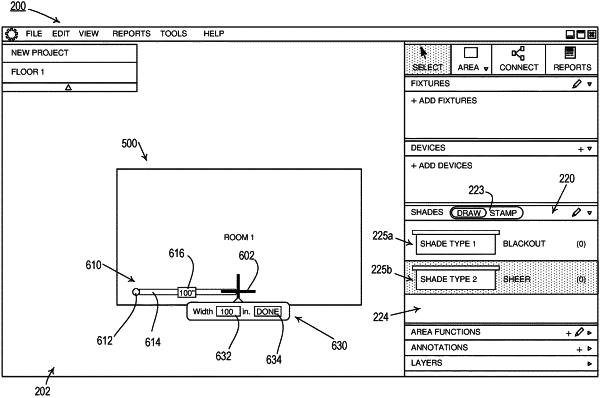| CPC G06F 3/04847 (2013.01) [G05B 15/02 (2013.01); G06F 3/0482 (2013.01); G06F 3/04817 (2013.01); G06F 3/04845 (2013.01); G06F 30/00 (2020.01); G06F 30/13 (2020.01); H05B 47/19 (2020.01); G06F 3/0486 (2013.01); G06F 3/04812 (2013.01)] | 42 Claims |

|
1. A method comprising:
displaying by at least one processor to a user on a display terminal a design window that comprises a canvas and a palette, wherein the palette comprises a shades pane;
displaying by the at least one processor to the user in the shades pane an indication of a shade type;
detecting by the at least one processor that the user selects the shade type from the shades pane, wherein selecting the shade type enables the user to define in the canvas a graphical representation of a physical shade of the selected shade type;
subsequent to determining that the user selects the shade type, determining by the at least one processor that the user places a cursor at a first location in the canvas, and determining by the at least one processor that the user enters a first command relative to the first location, wherein the first command comprises an indication that the user is defining a graphical representation of a physical shade of the selected shade type at the first location;
responsive to the user entering the first command, displaying by the at least one processor to the user in the canvas at the first location an operator icon that represents a drive unit of the physical shade;
subsequent to displaying the operator icon, determining by the at least one processor that the user moves the cursor to a second location in the canvas that is different from the first location;
responsive to determining that the user moves the cursor to the second location, displaying by the at least one processor to the user a first panel icon, wherein the first panel icon represents a first panel of the physical shade, wherein the first panel icon extends from the operator icon to at least the cursor, and wherein the first panel of the physical shade comprises two different dimensions including a length and a vertical height;
displaying by the at least one processor to the user a numerical value that represents the length of the first panel of the physical shade, wherein the numerical value changes as the cursor moves from the first location to the second location;
determining by the at least one processor that the user enters a second command, wherein the second command comprises an indication that the user is terminating a defining of the first panel;
subsequent to the second command, determining by the at least one processor whether the user is terminating the defining of the physical shade or is adding a second panel to the physical shade; and
responsive to determining that the user is terminating the defining of the physical shade:
determining by the at least one processor whether the length of the first panel of the physical shade, as defined by the user through the first panel icon, will cause a problem with the physical shade, wherein the problem includes whether the physical shade will sag because of the length; and
when it is determined that the length of the first panel of the physical shade, as defined by the user through the first panel icon, will cause a problem with the physical shade, displaying by the at least one processor an indication of the problem to the user on the display terminal.
|